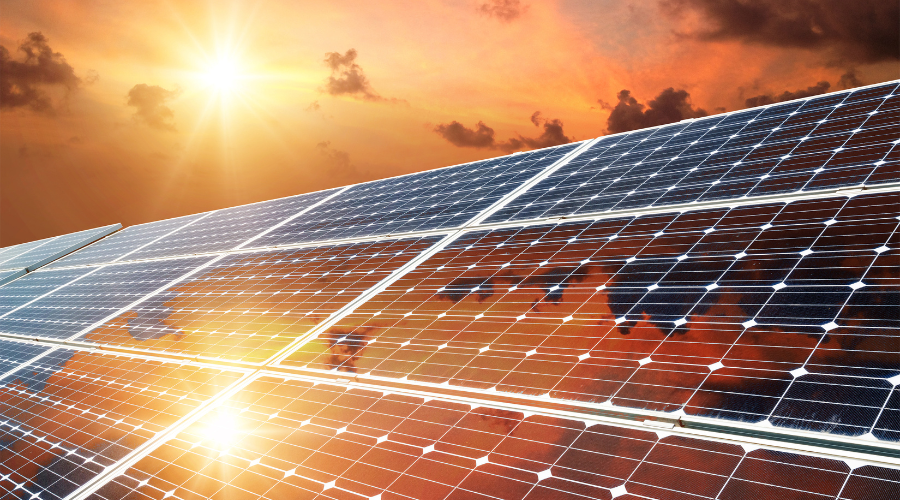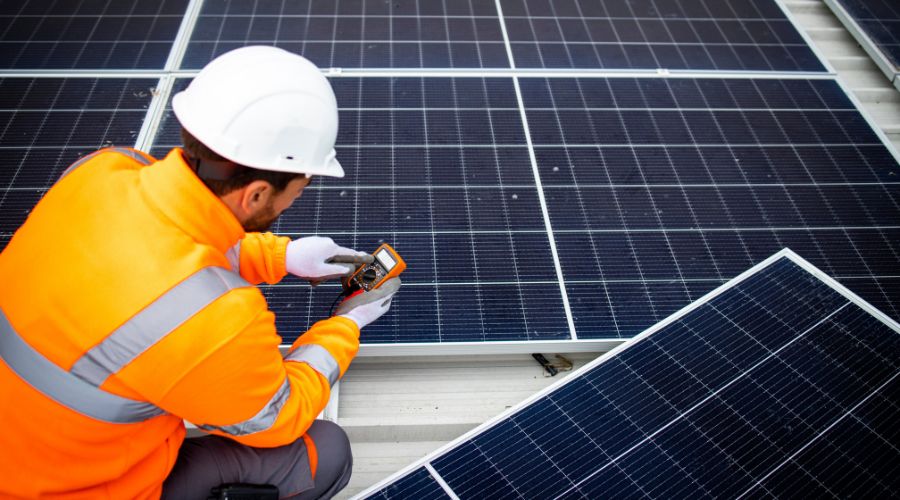
If you own land, you might also wonder, "how much do solar companies pay to lease land?". It's a tradeoff. Solar energy is good for the environment, but on the other hand, it costs more than traditional energy sources, usually natural gas, coal, and oil. So let's explore how much solar companies are willing to pay for your land with or without leases by looking at sample numbers.
Solar farm lease rates are between $0.25 and $1.00 per acre (see below for costs to farm or lease). Depending on location, you can make between $250 and $1000 per year.
That's not bad for a piece of land that most likely was not getting much use anyway. On the downside, you should expect to deal with some occasional traffic, noise, and occasional visual impacts. On the very off chance that your new neighbor is a nuclear power plant, you are looking at quite a lot of noise and traffic (see map below).
Since the value of solar energy usually far exceeds the cost of solar panels, solar farms can be very profitable. Solar farms lease land, so they have many acres of land available to them. The other 10% who have thousands of acres are not working at leasing that land because they own thousands of acres and don't need more land.
Understanding how solar farm works
To understand how solar farms work, let's look at a solar farm and explore the pros and cons.
There are many different types of solar farms.
Solar farms can be converted to regular industrial use very easily with an excavator and berming (which could be done by a contractor), but it is not that easy to convert a commercial building of any type to one that fits in a grid without converting the electricity used to gas or diesel-electric (and eventually perhaps fuel cells).
Solar panels are usually considered for permanent use. Gravel usage is also a major cost of gravel (the top 12% of the world's land uses).
Solar farms are usually surrounded by large amounts of desert and arid land (which decreases solar energy production). This costs more to farm because it takes more water resources to grow crops, especially in arid or desert conditions.
In the U.S., the value of solar energy far exceeds the cost of solar panels, which means that solar farms can be very profitable (depending on the investment return required).
Solar farm costs vary depending on size, technology, and location. For example, a solar farm in California will have different costs than one in Alaska. The cost to lease land depends on the size of the piece of land and other factors. A one-acre plot may cost $65 to $70 per month in California (with or without a contract).
How solar leasing works?
Let's walk through an example of a solar farm to understand how it works.
How much does a solar farm pay for your land? It seems like there is no way to get a reasonable answer to this question, but the amount is not that difficult to determine because of the value of solar energy. Let's look at how much a solar panel set costs and how much it'll pay you per year:
Example: Solar Panel Set Cost = $0.90
Solar Panel Set Annual Payout = $404.92 per year
These numbers are based on how much the solar panel costs, not how much it pays. The solar panel set is expected to pay for itself in 10 years since one panel will last ten years.
This is a common method for calculating several things - that's why it is called a mathematical model. In this case, the amount of electricity you get from the panels for 10 years is truly something to believe in.
If you have a small plot, your yearly payout is the same. The more land you have, the more money you get from solar panels.
So if you are leasing land for solar farms and need to know what does solar companies pay for your land?
The answer is simple - it depends! It depends on how much electricity a solar panel can produce yearly. You will also be paid at least minimum wage to keep the farm in good condition while they use your land.
Factors determining the cost of the lease
So here is what you can expect the price to be from a solar farm depending on the cost of land, contract, and quality of panel:
Solar farms usually cost between $2-4 per acre, but it depends on the quality and size of your land. A large plot may be a few hundred dollars per acre. The revenue potential is most significant when the solar panels are close to their maximum capacity (that's why they are called maximum output).
Other factors are the distance the panel is from the meetings, whether there are any existing structures, such as barns or homes, and maintenance needs (if you want a solar lease, you need to keep the barn roof in good shape).
Solar farms are costly. It can take thousands of acres to cover all your energy needs. Since every acre of land has some value, a solar farm owner tries to maximize revenues by having as much land as possible. The most common way to do this is by leasing land.
Substitute uses
There are hundreds of uses for solar farm power. One application of the technology is transmitting energy via microwave to another part of the country, which converts it to electricity using photovoltaic cells.
Other uses are:
The lack of available land in many places has given rise to homeowners residing in high-cost areas selling their homes or selling their land to a developer, who will build a typical residential community with housing and shopping centers on the property. This is done as some companies make use of eminent domain laws.
Some states (e.g., Florida) have laws that allow a solar farm to be built on residential property (as long as the owner at the time of the lease does not object and has been advised).
Solar farms have many uses, from using the land as a playground (maintaining the grass and cleaning up trash) to cleaning up and maintaining solar panels. Many solar companies hire people to do all of this work.
Electricity for homes and businesses can be converted into various forms.
Top states for solar leasing
The state with the most solar farms are California (65,000), Arizona (60,000), Colorado (50,000), New Jersey (31,000) and Massachusetts (28,000). In 2014 and 2015, Texas had the most solar farms operating in the United States.
As of October 1, 2016, 35 states had state or utility incentives for installing photovoltaic systems on homes and other buildings. By 2016, the cost of solar electricity had dropped 58% in the United States since 2010.
Other great states include:
- Vermont: Lease is $2.50/square foot
- Illinois: Lease is $1.75/square foot. Illinois is the nation's leader in commercial solar installations as of September 2016.
- Indiana: Lease is $1.20/square foot
- Georgia: Lease is 10 cents per watt (Solar 20 program)
- Wisconsin: Lease is $2.50/square foot
- Tennessee: Lease is $1.50/square foot
- Florida: Lease is $2.00/square foot
- Texas: Lease is $1.00/square foot
- Utah: Lease is $2.50/square foot
- Idaho: Lease is $0.50/square foot (or $1 per watt)
- Nevada: Lease is $1.
- Wyoming: Lease is $1.75/square foot
- North Carolina: Lease is $1.25/square foot
- Maryland: Lease is $0.
- Ohio: Lease is $0/square foot
- Delaware: The lease of an acre is $21.20 (as of 2016)
Indiana, Georgia, Tennessee, and Washington are now offering a community choice option (CCO) for alternative renewable energy. The Federal Communications Commission has approved a national standard for community choice programs.
Solar farm locations
Using the sun to power our day-to-day activities is one way to impact our planet positively. Solar farms can be built anywhere that is sunny and has enough land. Solar farms may be on leased land or land near transmission lines. Transmission lines are usually in rural areas, so it is easy to find a place for a solar farm.
Solar farm technology
The use of solar farms varies based on the technology used to generate energy. The old-fashioned solar power is based on solar panels that convert sunlight into electricity (photovoltaic). The most common form of photovoltaic today is crystalline silicon, a thin slice of semiconductor material cut from a larger crystal at a very low cost.
Many available technologies range from simple to very advanced (like concentrating solar power).
How much is your land worth?
The cost of land for solar farms depends on many things, such as the type of land, location, and quality of the land. The location also can be very important because some areas are more suitable for developing solar farms because of the type of soil, elevation, and proximity to transmission lines.
To know how much your land is worth, get a free consultation with Smart Energy USA.
How much money does an acre of solar panels generate?
On average, a 1-megawatt photovoltaic farm can generate about 10,000 MWh (megawatt-hours) per year. A solar panel farm can produce 2.5% of the nation’s electricity. It takes an acre of solar panels to generate enough power for 90 single-family homes. For more information, check out how much money a solar panel makes.
Are solar leases worth it?
Is solar energy good?
How do solar leasing companies make money?
How do you negotiate a solar lease?
How can you get ready to lease your land?
Unveiling the Advantages of Solar Energy: Benefits Explained
As we advance into the 21st century, the importance of transitioning from finite, pollutant fossil fuels to…
How does solar energy affect the environment?
Solar energy, an abundant and renewable power source, is becoming an increasingly integral part of the world’s…
Is Smart Energy Cheaper?
Everything talks about smart and renewable energy, but Is smart energy cheaper? In today’s technologically driven world,…
Shining Light on Solar: Where Does Solar Energy Come From?
As the world grapples with dwindling fossil fuel reserves and the escalating threat of climate change, the…
Big Dog Solar Review
Solar power in Idaho has become a popular and viable option as our world increasingly turns towards…
The Science Behind Solar Panels and How They Work
The Science Behind Solar Panels and How They Work Request A Quote Solar panels have emerged as…
Environmental Benefits of Solar Energy: Why It’s Time to Make the Switch
The Environmental Benefits of Solar Energy Request A Quote Contents What is solar energy? Solar energy is…
Which solar panel companies to avoid
Which solar panel companies to avoid 8 Tips that will save you money Want to know which…
7 Tips on How to choose a solar company
How to Choose a Solar Company? 7 Great Tips Thanks to energy incentives, solar panels are able…
How much does the electric company pay for solar power
How much does the electric company pay for solar power? how much does the electric company pay…
Save $1500-$2000
by Going Solar
Get a Free Quote & Report
Save $1500-$2000 by Going Solar
Want to now how much can you save?
Step1: Filled out the form below. We will review your information and be ready to tell you all the tax incentives and rebates in your area.










